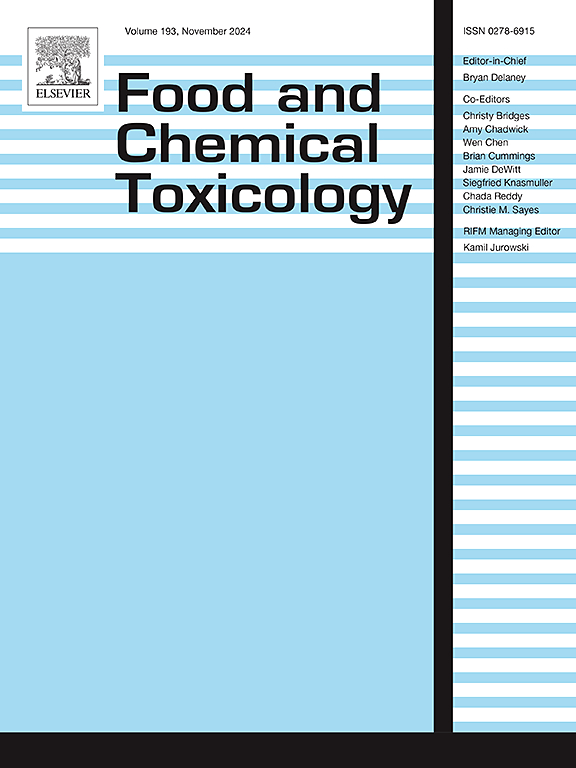20-Week toxicity study of rotigotine behenate extended-release microspheres for intramuscular injection in sprague dawley rats
IF 3.9
3区 医学
Q2 FOOD SCIENCE & TECHNOLOGY
引用次数: 0
Abstract
Based on the concept of continuous dopaminergic stimulation (CDS), Rotigotine Behenate extended-release microspheres for injection (RBEM) are currently under development. To support human clinical trials of RBEM, a 20-week repeat-dose toxicity study was conducted. SD rats intramuscularly received RBEM (60, 180, and 540 mg/kg) once every 4 weeks for 5 repeated doses followed by a 12-week recovery period, no clear sex difference was noted in the plasma exposure of rotigotine in rats, and the exposure generally increased in a dose-proportional manner. No obvious systemic toxicity occurred. Ovarian corpus luteum and breast acinar hypertrophy in rats were believed to be associated with the activation of dopamine receptors by RBEM and decreased prolactin levels. The reversible vacuolar degeneration or foamy macrophage infiltration at the injection site, adjacent tissues, and alveoli of rats were associated with local inflammation and foreign body removal reaction caused by PLGA and SCMC. In this study, the non-observed-adverse-effect-level (NOAEL) in rats was 540 mg/kg (based on rotigotine), which was equivalent to 24 times the maximum clinical recommended dose of RBEM, 448 mg/person/28 days (expressed as the dose of rotigotine behenate). In conclusion, RBEM exhibited a good safety margin and can be used in phase I clinical trials. Keywords: Parkinson's disease; RBEM; Continuous dopaminergic stimulation; Repeated dose toxicity.
罗替戈汀缓释微球肌肉注射对大鼠20周毒性研究。
基于持续多巴胺能刺激(CDS)的概念,目前正在开发注射用罗替戈汀缓释微球(RBEM)。为了支持RBEM的人体临床试验,进行了为期20周的重复给药毒性研究。SD大鼠肌注RBEM(60、180、540 mg/kg),每4周1次,共5次重复给药,恢复期12周,大鼠血浆罗替戈汀暴露量无明显性别差异,暴露量普遍呈剂量比例增加。未发生明显的全身毒性。大鼠卵巢黄体和乳腺腺泡肥大被认为与RBEM激活多巴胺受体和降低催乳素水平有关。大鼠注射部位、邻近组织和肺泡可逆性空泡变性或泡沫性巨噬细胞浸润与PLGA和SCMC引起的局部炎症和异物清除反应有关。在本研究中,大鼠未观察到的不良反应水平(NOAEL)为540 mg/kg(以罗替戈汀为基础),相当于RBEM临床最大推荐剂量448 mg/人/28天的24倍(以罗替戈汀的剂量表示)。综上所述,RBEM具有良好的安全边际,可用于I期临床试验。关键词:帕金森病;RBEM;持续多巴胺能刺激;重复剂量毒性。
本文章由计算机程序翻译,如有差异,请以英文原文为准。
求助全文
约1分钟内获得全文
求助全文
来源期刊

Food and Chemical Toxicology
工程技术-毒理学
CiteScore
10.90
自引率
4.70%
发文量
651
审稿时长
31 days
期刊介绍:
Food and Chemical Toxicology (FCT), an internationally renowned journal, that publishes original research articles and reviews on toxic effects, in animals and humans, of natural or synthetic chemicals occurring in the human environment with particular emphasis on food, drugs, and chemicals, including agricultural and industrial safety, and consumer product safety. Areas such as safety evaluation of novel foods and ingredients, biotechnologically-derived products, and nanomaterials are included in the scope of the journal. FCT also encourages submission of papers on inter-relationships between nutrition and toxicology and on in vitro techniques, particularly those fostering the 3 Rs.
The principal aim of the journal is to publish high impact, scholarly work and to serve as a multidisciplinary forum for research in toxicology. Papers submitted will be judged on the basis of scientific originality and contribution to the field, quality and subject matter. Studies should address at least one of the following:
-Adverse physiological/biochemical, or pathological changes induced by specific defined substances
-New techniques for assessing potential toxicity, including molecular biology
-Mechanisms underlying toxic phenomena
-Toxicological examinations of specific chemicals or consumer products, both those showing adverse effects and those demonstrating safety, that meet current standards of scientific acceptability.
Authors must clearly and briefly identify what novel toxic effect (s) or toxic mechanism (s) of the chemical are being reported and what their significance is in the abstract. Furthermore, sufficient doses should be included in order to provide information on NOAEL/LOAEL values.
 求助内容:
求助内容: 应助结果提醒方式:
应助结果提醒方式:


